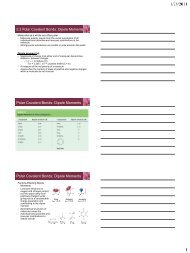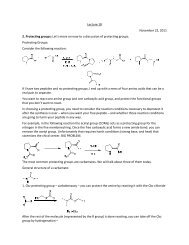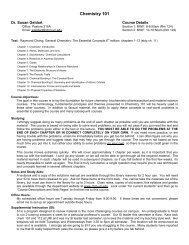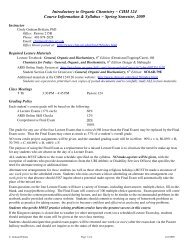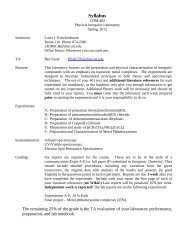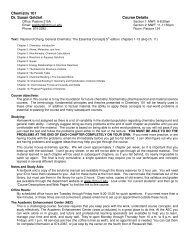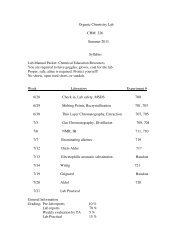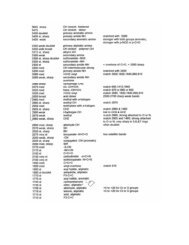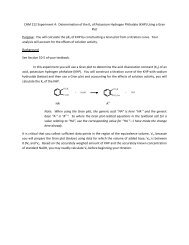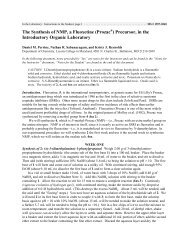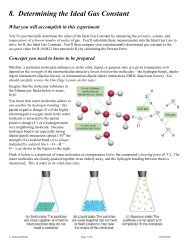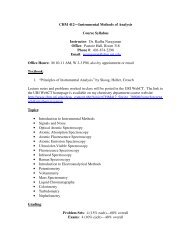You also want an ePaper? Increase the reach of your titles
YUMPU automatically turns print PDFs into web optimized ePapers that Google loves.
4. Determining the <strong>Chemical</strong> <strong>Formula</strong><strong>of</strong> an Ionic <strong>Compound</strong>What you will accomplish in this experimentYou’ve learned that compounds are a chemical combination <strong>of</strong> elements, meaning that they’re created when two ormore elements chemically react with one another. The driving force for that reaction is that the elements are tryingto achieve the stability <strong>of</strong> a noble gas electron configuration (for most elements, this means an s 2 p 6 “octet” <strong>of</strong>electrons.When the reacting elements are a metal and a nonmetal (elements with an electronegativity difference greater than2.0), the metal atom achieves its octet when it loses one or more electrons (to become a positively-charged ion, a“cation”), and the nonmetal atom gains those electrons (to become a negatively-charged ion, an “anion”).The chemical formula for the ionic compound that’s formed describes the fixed proportion in which vast numbers<strong>of</strong> the oppositely-charged ions combine in order to balance out the positive and negative charges.This idea is illustrated below for the chemical combination <strong>of</strong> the elements Sodium and Chlorine to make the ioniccompound: Sodium Chloride, NaCl.The ionic compound you’ll work with in this experiment is the chemical combination <strong>of</strong> the metal element Copper(Cu) and the same nonmetal element as above, Chlorine (Cl). When these elements chemically combine, the fixedproportion <strong>of</strong> ions in the compound can be expressed by the chemical formula, CuCl 2 , and by the compound’sname, Copper (II) Chloride.Your job will be to chemically separate these two elements, and then to determine the respective masses <strong>of</strong> Cu 2+and Cl - ions that were in your original sample <strong>of</strong> Copper (II) Chloride.By converting these masses <strong>of</strong> each element into “moles” (using the molar masses <strong>of</strong> Copper and Chlorine), andthen determining the “mole ratio” <strong>of</strong> the two elements in the compound, you should be able to proveexperimentally that the chemical formula for Copper (II) Chloride is, in fact, CuCl 2 .C. Graham Brittain Page 1 <strong>of</strong> 9 9/28/2010
Concepts you need to know to be preparedA compound’s chemical formula is made up <strong>of</strong> the symbols (from the Periodic Table) that represent each <strong>of</strong> theelements in that compound. And the numerical subscripts following these symbols indicate the fixed proportion inwhich the elements combine when that compound is formed by a chemical reaction.For an ionic compound (such as sodium chloride, NaCl), youshould NEVER think <strong>of</strong> that compound as just a PAIR <strong>of</strong>oppositely-charged ions, as the chemical formula seems to imply.If you look closely at the illustration <strong>of</strong> a sodium chloride (NaCl)salt crystal to the right, you’ll see that it is definitely NOT just apair <strong>of</strong> Na + and Cl - ions, but an extensive, orderly, threedimensionalnetwork <strong>of</strong> charged particles.Each Na + ion is attracted to the Cl - ions immediately above,below, to the right, to the left, in front, and behind it. And eachCl - ion is attracted to the Na + ions surrounding it.So it’s important to realize that the chemical formula for ANYionic compound does NOT describe a small grouping <strong>of</strong> ions, itdescribes the fixed proportion in which vast numbers <strong>of</strong> theoppositely-charged ions combine in order to appropriatelybalance out the positive and negative charges.So – one way to think about the chemical formula for Copper (II) Chloride, CuCl 2 , the ionic compound in thisweek’s experiment, is that it expresses the “ION ratio” <strong>of</strong> the elements in the compound:The compound CuCl 2 contains 2 Cl - IONS for every 1 Cu 2+ ION.But a “bigger picture” way to think about that chemical formula is that it expresses the “MOLE ratio” <strong>of</strong> theelements in the compound:The compound CuCl 2 contains 2 MOLES <strong>of</strong> Cl - ions for every 1 MOLE <strong>of</strong> Cu 2+ ions.One mole <strong>of</strong> any pure substance (element or compound) is really just an Avogadro’s number <strong>of</strong> “particles” <strong>of</strong> thatsubstance (where “particles” = atoms, ions, or molecules). For example:Or in the case <strong>of</strong> Copper (II) ions:1 mole <strong>of</strong> Copper metal = 6.02 x 10 23 Cu atoms1 mole <strong>of</strong> Copper (II) ions = 6.02 x 10 23 Cu 2+ ionsAn Avogadro’s number <strong>of</strong> atoms for a particular element, one MOLE <strong>of</strong> the element, will ALWAYS have a mass inGRAMS equal to the Atomic Weight listed for that element on the Periodic Table:Or for Copper (II) ions:1 mole <strong>of</strong> Copper (Cu) = 6.02 x 10 23 atoms <strong>of</strong> copper = 63.55 grams <strong>of</strong> Copper metal1 mole <strong>of</strong> Copper (II) ions = 6.02 x 10 23 Cu 2+ ions = 63.55 grams <strong>of</strong> Copper (II) ionsNOTE: The mass in grams <strong>of</strong> 1 mole <strong>of</strong> any pure substance is commonly referred to as the “Molar Mass.”A similar unit relationship is easily determined for any other element on the Periodic Table. The first part <strong>of</strong> thisunit relationship is always the same:1 mole <strong>of</strong> any element = 6.02 x 10 23 atoms <strong>of</strong> that elementC. Graham Brittain Page 2 <strong>of</strong> 9 9/28/2010
Péter Orsolya: »Feminae improbissimae« 79A fenti klasszikus kori szöveg azért figyelemre méltó, mert a jogtudós nem operálazzal az ismert közhellyel, hogy a nők „könnyelmű természetük” 7 vagy a női nem„veleszületett gyengesége” 8 miatt eleve alkalmatlanok bizonyos feladatok betölté-7 A híres szöveghelyen (Inst. 1.144.) Gaius a veteres, a préklasszikus kor jogtudósainak véleményét idézia serdült nők felett fennálló gyámság indokolásával kapcsolatban: „Veteres enim voluerunt feminas,etiamsi perfectae aetatis sint, propter animi levitatem in tutela esse” – „A régiek ugyanis azt akarták,hogy a nők, mégha teljes korúak is, felfogásuk könnyelműsége miatt gyámság alatt legyenek.” Gaiusinstitúciói. Fordította Brósz Róbert, Budapest, Nemzeti Tankönyvkiadó, 1996.8 A nők veleszületett gyengeségét és bizonyos feladatokra való alkalmatlanságát a római szöveghelyekaz infirmitas sexus, esetleg az imbecillitas sexus szófordulatokkal írják le – amely azonban, mindennegatív felhangja ellenére, a nők számára bizonyos esetekben kedvezőbb jogi helyzetet is eredményezhetett.Így például a D. 16.2.2. szöveghelyen (Ulpianus libro vicensimo nono ad edictum) a nőkintercessio-ját tiltó Senatusconsultum Velleianum-ra vonatkozó fejtegetést Ulpianus így vezeti be:„Verba itaque senatus consulti excutiamus prius providentia amplissimi ordinis laudata, quia opem tulitmulieribus propter sexus inbecillitatem multis huiuscemodi casibus suppositis atque obiectis” – vizsgáljukmeg tehát ennek a senatusconsultumnak a szavait, de csak azt követően, hogy megdicsértük e kiválótestület előrelátását, mely nemük gyengesége (sexus imbecillitas) indokán számos feltételezett éstényleges esetben segítséget nyújtott a nőknek. A D. 22.6.9. pr. (Paulus libro singulari de iuris et factiignorantia) jogbeli és ténybeli tévedéssel foglalkozó szöveghelyén Paulus a jogban való tévedésről értekezik,és megállapítja, hogy „Regula est iuris quidem ignorantiam cuique nocere, facti veroignorantiam non nocere. Videamus igitur, in quibus speciebus locum habere possit, ante praemissoquod minoribus viginti quinque annis ius ignorare permissum est. Quod et in feminis in quibusdamcausis propter sexus infirmitatem dicitur: et ideo sicubi non est delictum, sed iuris ignorantia, nonlaeduntur.” – az a szabály, hogy a jog ismeretének hiánya árt, a tények ismeretének hiánya pedignem árt. Ezért lássuk, hogy a fenti szabálynak milyen esetekben lehet helye, elsőként előrebocsátva,hogy a 25 évnél fiatalabbaknak megengedik, hogy ne ismerjék a jogot, és bizonyos esetekben ugyaneza helyzet a nőkkel, nemük gyengesége miatt („propter sexus infirmitatem”): így mindaddig, amígnem bűncselekményt követnek el, hanem a jog ismeretének hiányáról van szó, jogaik nem sérülnek. ACodex egyik, Kr. u. 530-ban kiadott császári konstitúciója szerint (C. 4.29.22. Iustinianus) ha egynagykorú nő elzálogosít valamit vagy más biztosítékot ad, majd két év elteltével ugyanabban az ügybenmég egyszer biztosítékot ad, a császár rendelkezése szerint a második biztosítékadás nem érvényes,hiszen a nő gyengesége miatt („ex consequentia suae fragilitatis”) tette ki magát másodszor isveszteségnek. Az infirmitas/imbecillitas sexus megítélésével kapcsolatosan ld. Siro Solazzi: Infirmitasaetatis e infirmitas sexus, Archivio Giuridico 45, 1930, 3-31. old. = Scritti di diritto romano III., Napoli,Jovene, 1960, 357-367.old.; Adolf Berger: Encyclopedic Dictionary <strong>of</strong> Roman Law, Philadelphia, TheAmerican Philosophical Society, 1953 (Transactions <strong>of</strong> the American Philosophical Society, New Series43 (1953) 2),”infirmitas sexus” címszó alatt; Suzanne Dixon: Infirmitas sexus: Womanly Weakness inRoman Law, Tijdschrift voor Rechtsgeschiedenis 52 (1984) 4., 343-371.o.; Renato Quadrato:Infirmitas sexus e levitas animi: il sesso ”debole” nel linguaggio dei giuristi romani, in: Scientia iurislinguaggio nel sistema giuridico romano (szerk. Francesco Sini, Rosanna Ortu) Torino, Giappichelli,2002, 155-194. o. A nők veleszületett gyengeségének toposza a római kort követően gyakorlatilag aXX. század elejéig tartotta magát; ezzel kapcsolatosan ld. Marina Graziosi: Infirmitas sexus. La donnanell'immaginario penalistico, Democrazia e diritto, 2 (1993), 99-143.o. A fentiekkel kapcsolatosan akaratlanulis bizarr bizonyítékot szolgáltat a Women in the World's Legal Pr<strong>of</strong>essions (szerk. UlrikeSchultz, Gisela Shaw, Hart Publishing, Oxford, 2003.) című tanulmánykötet, melyben a világ különbözőországaiból származó szerzők mutatják be a nők által hazájukon belül az igazságszolgáltatásban betöltöttszerepeket. Az olaszországi helyzetet bemutató tanulmány (Pr<strong>of</strong>essional Body and GenderDifference in Court: the Case <strong>of</strong> the First (Failed) Woman Lawyer in Modern Italy, 419-435. o.) LidiaPoet esetével foglalkozik, akit 1883-ban nagy vita után hivatalosan is felvettek a torinói ügyvédi kamarába,de a döntést a helyi bíróságnál szinte azonnal megtámadták és elérték a jogot végzett asszonykamarából történő kizárását, majd a legmagasabb szintű fórumként eljáró Semmítőszék helybenhagytaaz alsóbb fokú bíróság döntését. Lidia Poet története mellett a szerző más, ugyanilyen sorsra jutott,jogvégzett nők élettörténetét is felidézi, továbbá hivatkozik az infirmitas sexus mélyen gyökeredző
If it’s not, you’ll need to think back through the various steps <strong>of</strong> the procedure, identify the possible sources <strong>of</strong>experimental error, and consider how each source <strong>of</strong> error might have contributed to making your experimentalresult too high or too low.You can see that it’s essential to do a good job <strong>of</strong> recording your data and observations, so that you’ll be able tomake a thorough assessment as to why your experimental result is higher or lower than the true value.Procedure that you will follow1. Measure a known mass <strong>of</strong> copper (II) chloride into a 250-mL beaker (approximately 3 grams, but weighed tothe maximum number <strong>of</strong> significant figures provided by the balance).2. Add approximately 60 mL <strong>of</strong> distilled water to the beaker and stir until the copper (II) chloride has completelydissolved. The resulting solution should be the brilliant blue color that is characteristic <strong>of</strong> Cu 2+ ions in aqueoussolution.3. Your lab instructor will provide you with an aluminum wire and demonstrate how to shape it into a coil. Takea moment to measure the initial mass <strong>of</strong> the wire. You’ll then immerse the coiled end <strong>of</strong> the wire in the coppersolution. Maintain your grasp on the other end <strong>of</strong> the rod, so that you can use it to stir the reaction mixture.4. Watch closely to observe the chemical reaction that occurs, and make detailed notes <strong>of</strong> your observations inyour lab notebook.IMPORTANT: Be sure to review the Skills in Recording Observations provided in the Remedies document:When recording observations <strong>of</strong> a substance, describe everything that you see (or perhaps smell): Is thesubstance a solid, liquid, or gas? Is it a solution? What color is it? Is it opaque, translucent, or transparent? Ifyou are instructed to waft the vapors toward your nose, does the substance have an odor?When recording observations <strong>of</strong> a reaction, first write down what you did (heat a solution, or add one chemicalto another and mix thoroughly). Then write down what you saw, heard, smelled, or felt with your fingertips:Was there a color change? Did a gas evolve? Did a solid form? Was an odor emitted? Was there any sound?Was any heat evolved? (If yes, monitor the temperature change with your thermometer, and record it as anobservation.) How long did it take for the reaction to occur?A Note on Common Sense and Experimental Technique:Because the chemical reaction between the Cu 2+ ions and the Al atoms is taking place on the surface <strong>of</strong> thealuminum wire, the copper metal that’s produced by the reaction will accumulate on that surface. So you’llneed to use your metal spatula or glass stirring rod to scrape or knock the copper metal <strong>of</strong>f the wire as thereaction progresses. The goal is to keep exposing the aluminum surface to the solution so that the reaction cancontinue all the way to completion (until all <strong>of</strong> the copper ions in the solution have been converted to coppermetal).5. When the reaction appears to be complete, remove the aluminum wire, rinse and dry it thoroughly, determineits final mass, and then return it to your lab instructor.6. Now you’ll need to separate the copper metal from the reaction mixture by vacuum filtration. In preparationfor this procedure, pre-weigh a piece <strong>of</strong> filter paper (that fits in the Buchner funnel) with your watchglass. Setup the vacuum filtration apparatus as illustrated in the LabCam video and described in the Remedies document.Be sure to follow the steps carefully – especially securing the Buchner funnel to the filter flask with the rubberadaptor, and clamping the neck <strong>of</strong> the filter flask to a ring stand. Ask your lab instructor to inspect yourvacuum filtration set-up before you begin filtration.7. As shown in the video, you’ll need to place your pre-weighed filter paper in the Buchner funnel, pre-moisten itwith water, and make certain that the wet paper forms a seal against the funnel when the vacuum is turned on.C. Graham Brittain Page 4 <strong>of</strong> 9 9/28/2010
Then pour the mixture into the center <strong>of</strong> the funnel. Remember that you can use small squirts <strong>of</strong> distilled waterfrom your plastic wash bottle to rinse the copper from the beaker into the funnel.8. As the final step to the vacuum filtration, rinse the copper metal in the funnel with several squirts <strong>of</strong> acetonefrom the plastic squeeze bottle provided in the hood. Acetone is a volatile organic solvent, so it will help thecopper dry more quickly. You should also allow the vacuum to pull air through the copper for several minutes,to remove excess liquid and hasten drying.9. Then carefully transfer the wet filter paper and copper metal from the funnel to the pre-weighed watch lass. Besure to spread the copper across the surface <strong>of</strong> the watchglass to enable its drying. Mark the watchglass withyour initials, and then place it in the heated oven to dry. When the drying and cooling is complete, weigh andrecord the mass <strong>of</strong> the watchglass (containing the dried filter paper and copper). The mass <strong>of</strong> the copper metalcan be determined by difference.10. Then by difference, determine the mass <strong>of</strong> chlorine in your original sample <strong>of</strong> copper (II) chloride.11. Use Atomic Weights from the Periodic Table to convert your masses <strong>of</strong> copper and chlorine to moles, thendetermine your experimental mole ratio <strong>of</strong> chlorine to copper.IMPORTANT: You MUST dispose <strong>of</strong> all chemical waste as directed by your lab instructor. Do NOT put anychemical waste in the laboratory sinks or garbage cans. Use the solid and liquid waste containers in the hood asdirected by your lab instructor.ALSO IMPORTANT: Please thoroughly clean your laboratory glassware before replacing it in your equipmentdrawer. Large Nalgene bottles <strong>of</strong> soap solution are provided near the laboratory sinks. You should notify your labinstructor if the stock <strong>of</strong> soap solution is running low.C. Graham Brittain Page 5 <strong>of</strong> 9 9/28/2010
Report Sheet 4: <strong>Chemical</strong> <strong>Formula</strong> <strong>of</strong> a <strong>Compound</strong>Student ______________________________ Lab Partner__________________________ Date Lab Performed__________Section #_________ Lab Instructor__________________________________________ Date Report Received ___________Lab Notebook: Data and ObservationsExperimental Data:Mass <strong>of</strong> empty 250-mL beakerMass <strong>of</strong> 250-mL beaker with copper (II) chloride sampleMass <strong>of</strong> copper (II) chloride sample (by subtraction)Mass <strong>of</strong> aluminum wire before reactionMass <strong>of</strong> aluminum wire after reactionMass <strong>of</strong> watchglass and filter paper (pre-weighed)Mass <strong>of</strong> watchglass, filter paper, and dried copper metal_________________________________________________________________________________________________________________________________________________________________Additional Data:Molar Mass <strong>of</strong> CopperMolar Mass <strong>of</strong> Chlorine______________________________________________Observations: Initial physical appearances <strong>of</strong> the copper (II) chloride solid, aqueous solution, and the aluminum wire. <strong>Chemical</strong> reaction <strong>of</strong> the aluminum wire with the copper solution, including the temperature change. Final physical appearance <strong>of</strong> the copper metal, aluminum wire, and filtered solution.C. Graham Brittain Page 6 <strong>of</strong> 9 9/28/2010
Formal Report: Results and ConclusionsChange in mass <strong>of</strong> aluminum rodCalculation:_______________________Mass <strong>of</strong> copper metal produced by the reactionCalculation:_______________________Mass <strong>of</strong> chlorine in original sample <strong>of</strong> copper (II) chlorideCalculation:_______________________Number <strong>of</strong> moles <strong>of</strong> copper metalCalculation:_______________________Number <strong>of</strong> moles <strong>of</strong> chlorineCalculation:_______________________Experimentally determined mole ratio <strong>of</strong> chlorine to copperCalculation:_______________________<strong>Chemical</strong> formula <strong>of</strong> copper (II) chloride as determined experimentally_______________________C. Graham Brittain Page 7 <strong>of</strong> 9 9/28/2010
Additional Questions:1. One way to express the fixed proportion <strong>of</strong> elements in the compound copper (II) chloride is the chemicalformula. Another way is the Mass Percent <strong>of</strong> each element in the compound. For example:The “theoretical” Mass Percent <strong>of</strong> copper in the compound (as predicted by the true chemical formula, CuCl 2 ),would be:Complete this calculation and determine the Theoretical Mass Percent <strong>of</strong> Copper in copper (II) chloride:2. Now calculate the Mass Percent <strong>of</strong> Copper from your experimental data:3. Compare your experimental mass percent <strong>of</strong> copper to the theoretical value by calculating the Percent Error.C. Graham Brittain Page 8 <strong>of</strong> 9 9/28/2010
4. Thoroughly explain why your experimental mass percent is different from the theoretical value.Think about what you observed: Was there any color remaining in the solution after your vacuum filtration? Wasany copper metal lost in transfer or filtration? Was the copper metal still moist when it was weighed?Be specific as to how each possible source <strong>of</strong> error would have affected the outcome; that is, caused the masspercentage <strong>of</strong> copper to be higher or lower than the theoretical value.Finally, explain where you could improve your technique if you repeated the experiment.5. Thought Question: How did the change in mass <strong>of</strong> the aluminum rod compare to the mass <strong>of</strong> copper producedby the chemical reaction? Larger? Smaller? The same? And is this result consistent with your expectation?Explain your reasoning.C. Graham Brittain Page 9 <strong>of</strong> 9 9/28/2010



